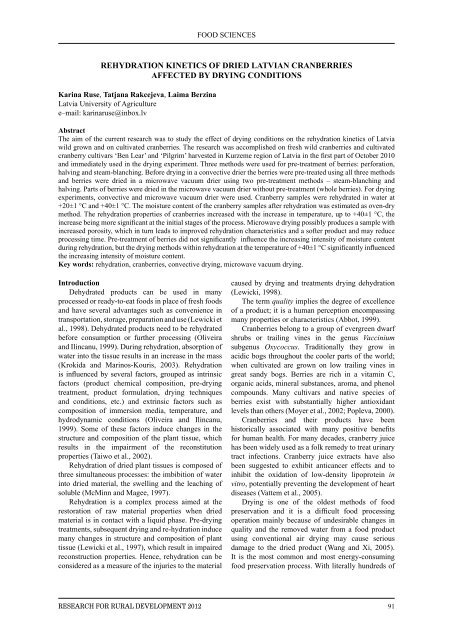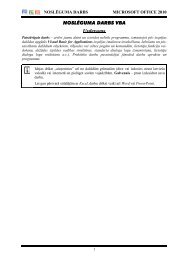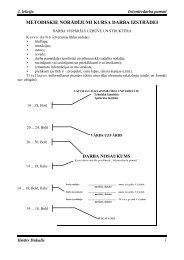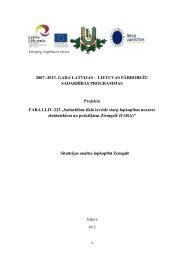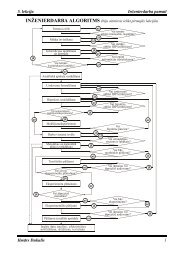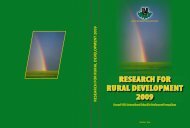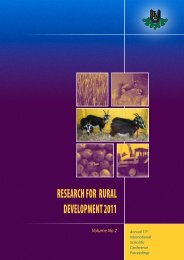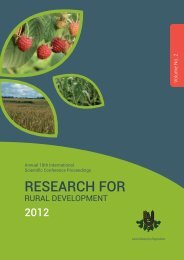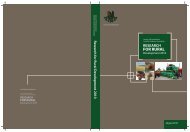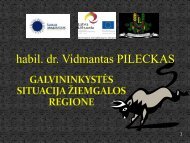LATVIA UNIVERSITY OF AGRICULTURE - Latvijas ...
LATVIA UNIVERSITY OF AGRICULTURE - Latvijas ...
LATVIA UNIVERSITY OF AGRICULTURE - Latvijas ...
- No tags were found...
Create successful ePaper yourself
Turn your PDF publications into a flip-book with our unique Google optimized e-Paper software.
FOOD SCIENCESreHYDRATION KINETICS <strong>OF</strong> DRIED Latvian cranberriesAFFECTED BY DRYING CONDITIONSKarina Ruse, Tatjana Rakcejeva, Laima BerzinaLatvia University of Agriculturee–mail: karinaruse@inbox.lvAbstractThe aim of the current research was to study the effect of drying conditions on the rehydration kinetics of Latviawild grown and on cultivated cranberries. The research was accomplished on fresh wild cranberries and cultivatedcranberry cultivars ‘Ben Lear’ and ‘Pilgrim’ harvested in Kurzeme region of Latvia in the first part of October 2010and immediately used in the drying experiment. Three methods were used for pre-treatment of berries: perforation,halving and steam-blanching. Before drying in a convective drier the berries were pre-treated using all three methodsand berries were dried in a microwave vacuum drier using two pre-treatment methods – steam-blanching andhalving. Parts of berries were dried in the microwave vacuum drier without pre-treatment (whole berries). For dryingexperiments, convective and microwave vacuum drier were used. Cranberry samples were rehydrated in water at+20±1 °C and +40±1 °C. The moisture content of the cranberry samples after rehydration was estimated as oven-drymethod. The rehydration properties of cranberries increased with the increase in temperature, up to +40±1 °C, theincrease being more significant at the initial stages of the process. Microwave drying possibly produces a sample withincreased porosity, which in turn leads to improved rehydration characteristics and a softer product and may reduceprocessing time. Pre-treatment of berries did not significantly influence the increasing intensity of moisture contentduring rehydration, but the drying methods within rehydration at the temperature of +40±1 °C significantly influencedthe increasing intensity of moisture content.Key words: rehydration, cranberries, convective drying, microwave vacuum drying.IntroductionDehydrated products can be used in manyprocessed or ready-to-eat foods in place of fresh foodsand have several advantages such as convenience intransportation, storage, preparation and use (Lewicki etal., 1998). Dehydrated products need to be rehydratedbefore consumption or further processing (Oliveiraand Ilincanu, 1999). During rehydration, absorption ofwater into the tissue results in an increase in the mass(Krokida and Marinos-Kouris, 2003). Rehydrationis influenced by several factors, grouped as intrinsicfactors (product chemical composition, pre-dryingtreatment, product formulation, drying techniquesand conditions, etc.) and extrinsic factors such ascomposition of immersion media, temperature, andhydrodynamic conditions (Oliveira and Ilincanu,1999). Some of these factors induce changes in thestructure and composition of the plant tissue, whichresults in the impairment of the reconstitutionproperties (Taiwo et al., 2002).Rehydration of dried plant tissues is composed ofthree simultaneous processes: the imbibition of waterinto dried material, the swelling and the leaching ofsoluble (McMinn and Magee, 1997).Rehydration is a complex process aimed at therestoration of raw material properties when driedmaterial is in contact with a liquid phase. Pre-dryingtreatments, subsequent drying and re-hydration inducemany changes in structure and composition of planttissue (Lewicki et al., 1997), which result in impairedreconstruction properties. Hence, rehydration can beconsidered as a measure of the injuries to the materialcaused by drying and treatments drying dehydration(Lewicki, 1998).The term quality implies the degree of excellenceof a product; it is a human perception encompassingmany properties or characteristics (Abbot, 1999).Cranberries belong to a group of evergreen dwarfshrubs or trailing vines in the genus Vacciniumsubgenus Oxycoccus. Traditionally they grow inacidic bogs throughout the cooler parts of the world;when cultivated are grown on low trailing vines ingreat sandy bogs. Berries are rich in a vitamin C,organic acids, mineral substances, aroma, and phenolcompounds. Many cultivars and native species ofberries exist with substantially higher antioxidantlevels than others (Moyer et al., 2002; Popleva, 2000).Cranberries and their products have beenhistorically associated with many positive benefitsfor human health. For many decades, cranberry juicehas been widely used as a folk remedy to treat urinarytract infections. Cranberry juice extracts have alsobeen suggested to exhibit anticancer effects and toinhibit the oxidation of low-density lipoprotein invitro, potentially preventing the development of heartdiseases (Vattem et al., 2005).Drying is one of the oldest methods of foodpreservation and it is a difficult food processingoperation mainly because of undesirable changes inquality and the removed water from a food productusing conventional air drying may cause seriousdamage to the dried product (Wang and Xi, 2005).It is the most common and most energy-consumingfood preservation process. With literally hundreds ofResearch for Rural Development 201291


